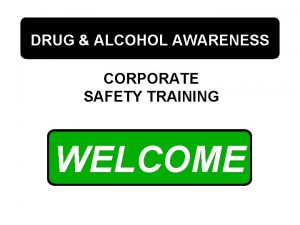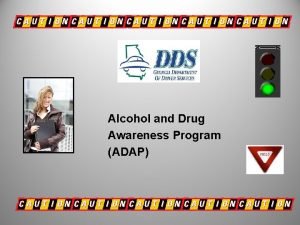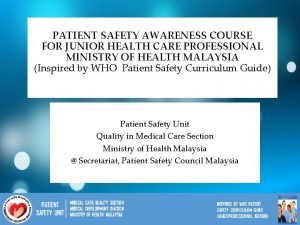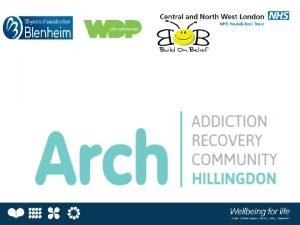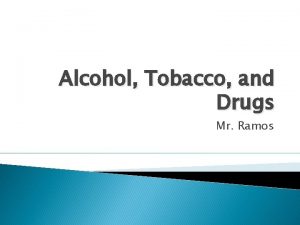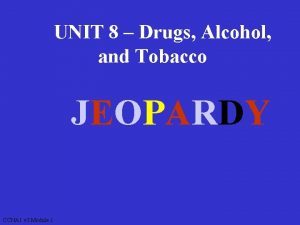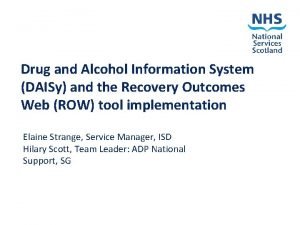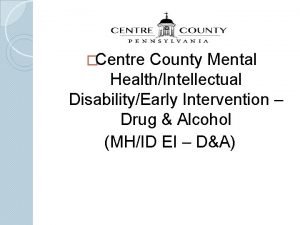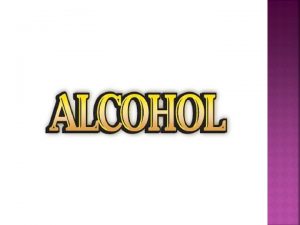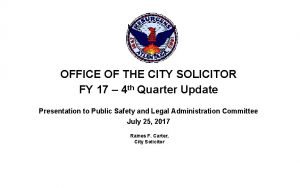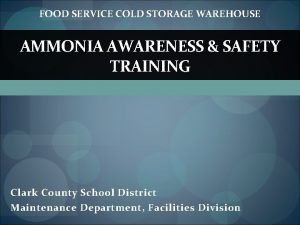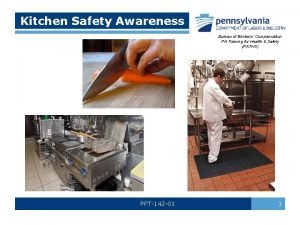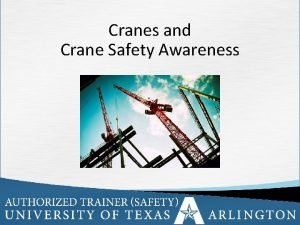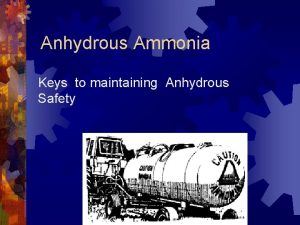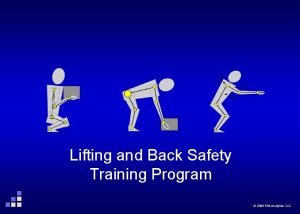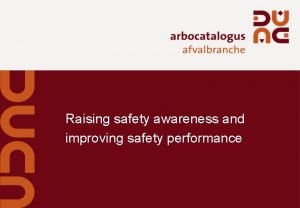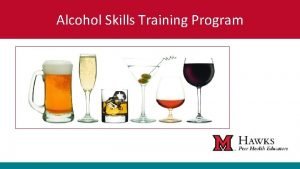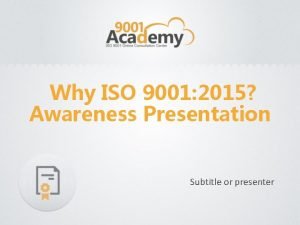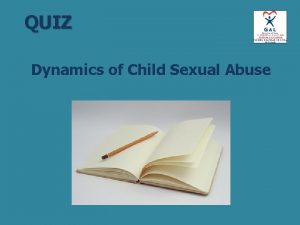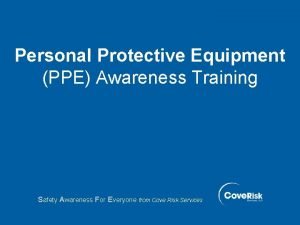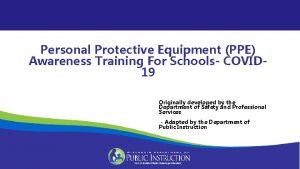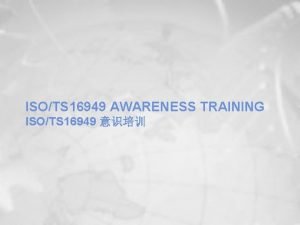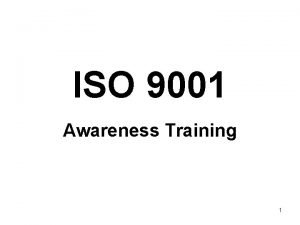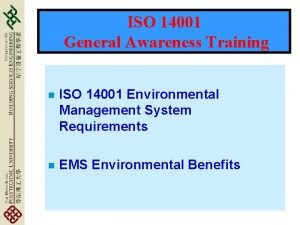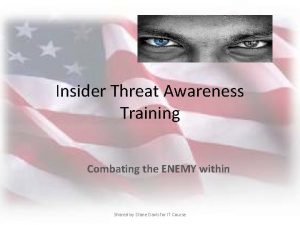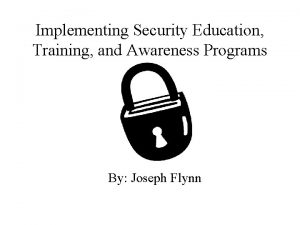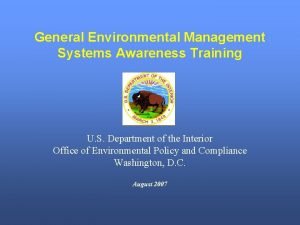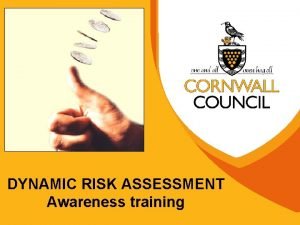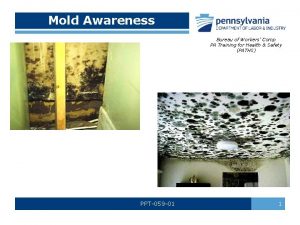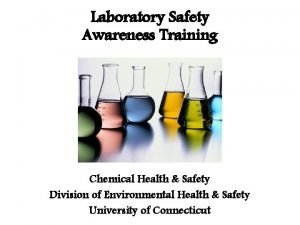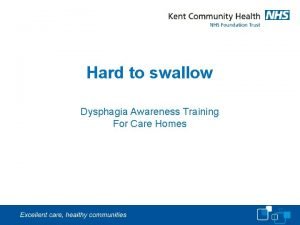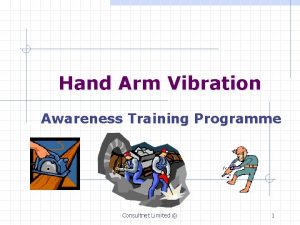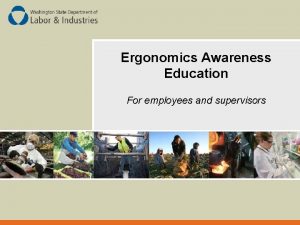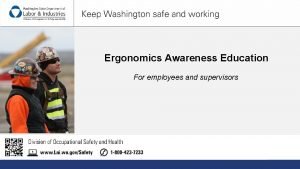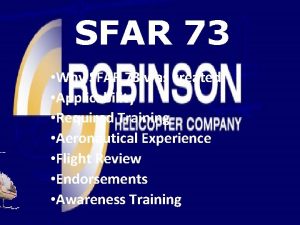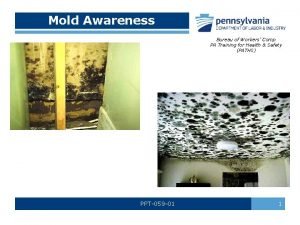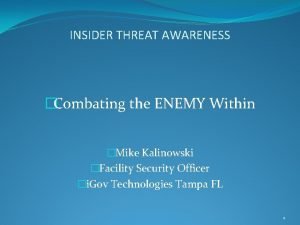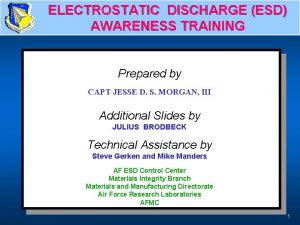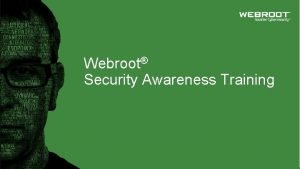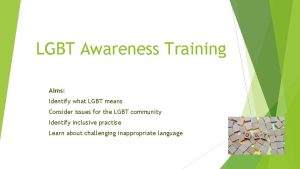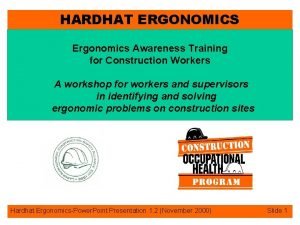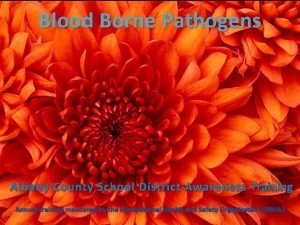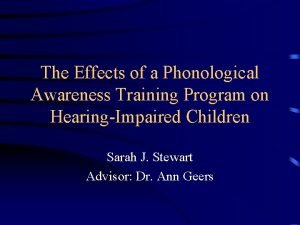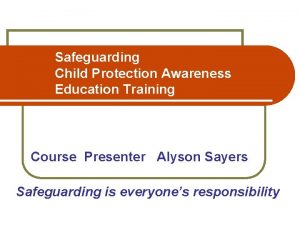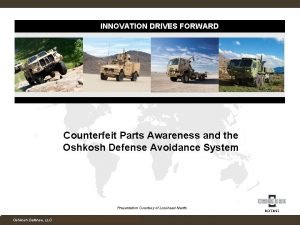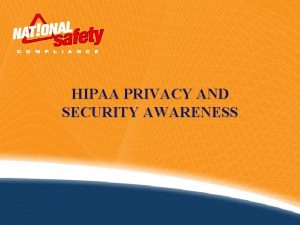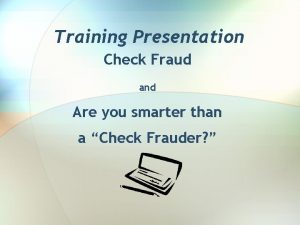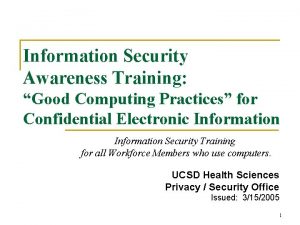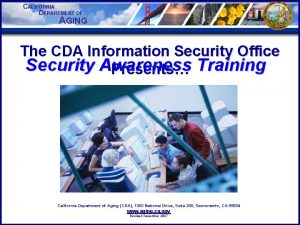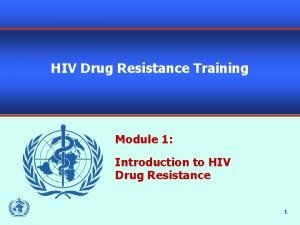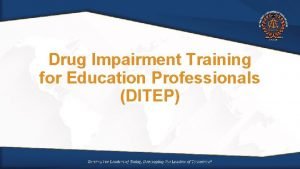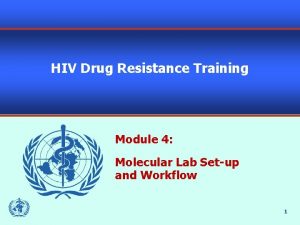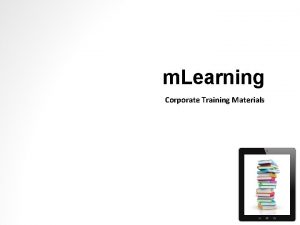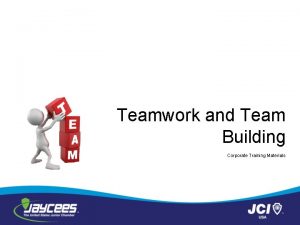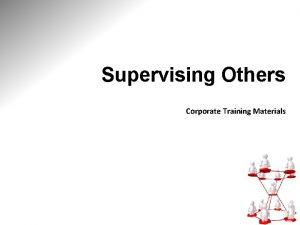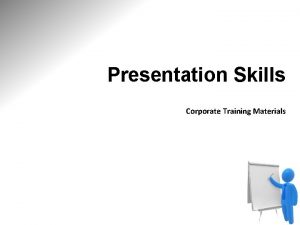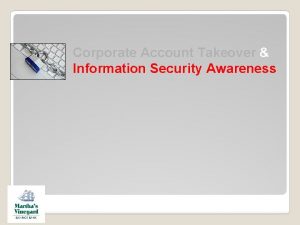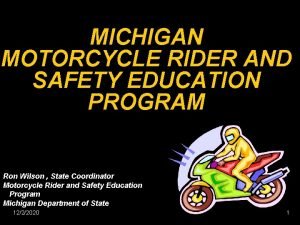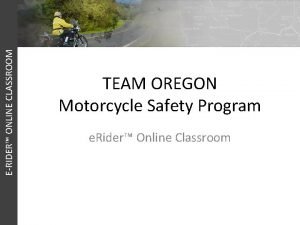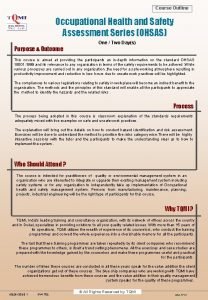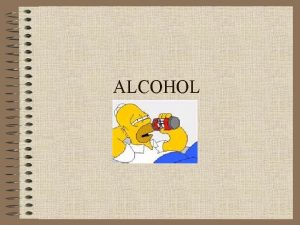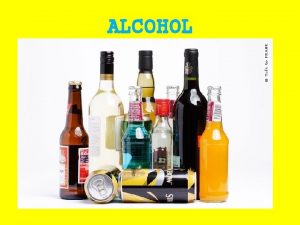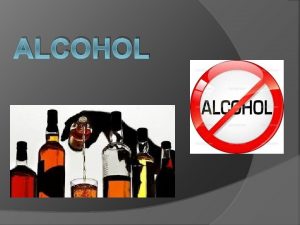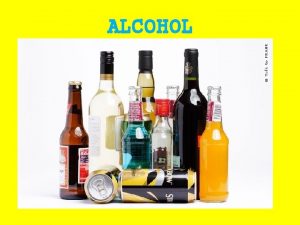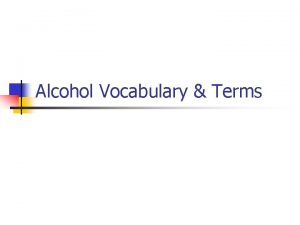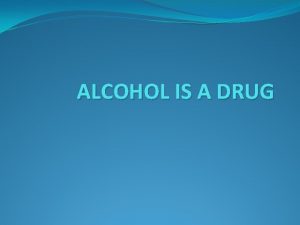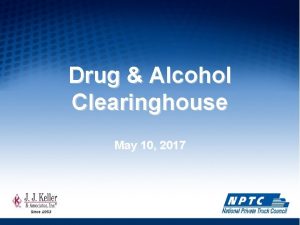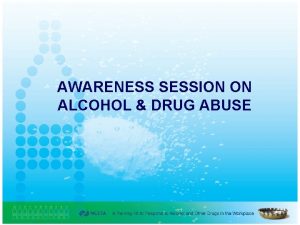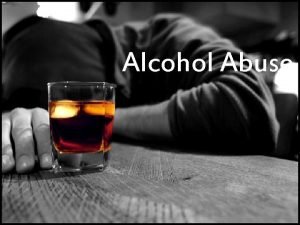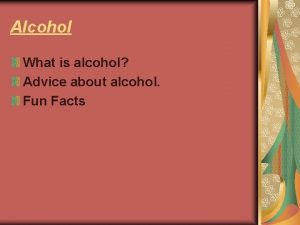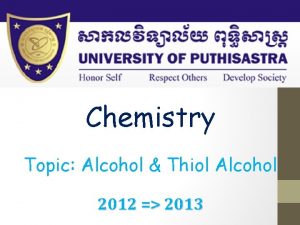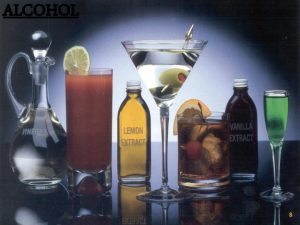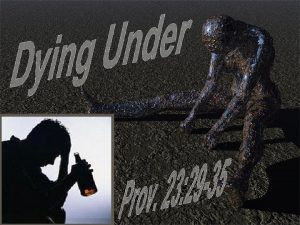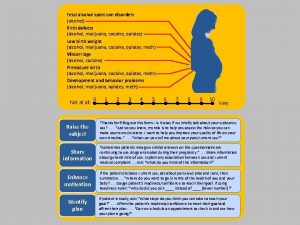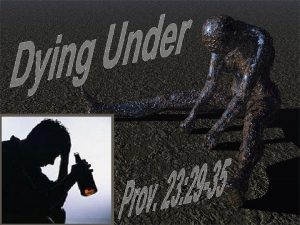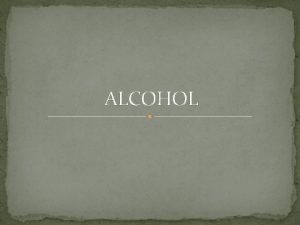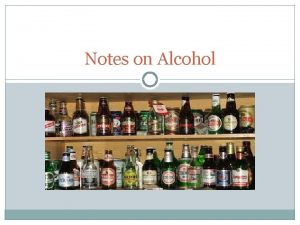DRUG ALCOHOL AWARENESS CORPORATE SAFETY TRAINING WELCOME COURSE


















































































- Slides: 82

DRUG & ALCOHOL AWARENESS CORPORATE SAFETY TRAINING WELCOME

COURSE OBJECTIVES þ Discuss the Components of an Effective Program. þ Introduce Ideas to Help Develop an Effective Program. þ Discuss the Drug-Free Workplace Policy. þ Clarification of the Expected Roles of Employers. þ Clarification of the Expected Roles of Employees. þ Explanation of the Effects of Drug Use. þ Overview of Rehabilitative Services. þ Overview of Drug Testing Methods.

REGULATORY STANDARD THE GENERAL DUTY CLAUSE FEDERAL - 29 CFR 1903. 1 EMPLOYERS MUST: Furnish a place of employment free of recognized hazards that are causing or are likely to cause death or serious physical harm to employees. Employers must comply with occupational safety and health standards promulgated under the Williams. Steiger Occupational Safety and Health Act of 1970. OSHA ACT OF 1970

APPLICABLE REGULATIONS Continued FEDERAL REQUIREMENTS THE DRUG-FREE WORKPLACE ACT OF 1988: þ þ þ þ 1986 - Signed by the President. 1988 - Congress Passed the Drug-Free Workplace Act. Affects Federal Grantees Receiving $25, 000 or More. Affects Federal Contracts Receiving $25, 000 or More. Requires a Written Policy. Requires that Employees Read and Consent to the Policy. Requires that an Awareness Program be Instituted. Employees Must Disclose Any Drug Related Conviction in the Workplace to the Employer Within 5 Days of the Conviction.

APPLICABLE REGULATIONS Continued FEDERAL REQUIREMENTS THE DRUG-FREE WORKPLACE ACT OF 1988: Continued þ Employers must Disclose Any Drug Related Conviction in the Workplace to the Federal Agency with Which the Employer has a Grant or Contract Within 10 Days of the Conviction. þ Employers Must Make an Ongoing Effort to Maintain a Workplace Free of Drugs.

APPLICABLE REGULATIONS Continued STATE REQUIREMENTS VARY FROM STATE TO STATE: þ þ þ þ Some States, CA, AL, FL, WA and Others Have Programs. Many States Offer Workers’ Compensation Discounts. Criteria are Similar but No Standard Model Exists. Employers Must Meet Certification Criteria in Each State. Employers Must Maintain Certifications to Participate. Certain Fees May be Required of the Employer. De-certification Can Occur for Various Reasons.

APPLICABLE REGULATIONS Continued STATE REQUIREMENTS TYPICAL STATE REQUIREMENTS: þ þ þ þ A Corporate Policy Statement. Employee Notification of the Policy. Employee Notification of Substance Abuse Testing Program. Employee Assistance Program. Supervisor Training. Employee Training. Agreements to Confidentiality.

APPLICABLE REGULATIONS Continued STATE REQUIREMENTS SPECIFIC REQUIREMENTS OF THIS STATE INCLUDE:

APPLICABLE REGULATIONS Continued FOR SPECIFIC STATE REQUIREMENTS Contact the State Attorney General or GUIDE TO STATE DRUG TESTING LAWS Published by: Institute for a Drug-Free Workplace 1225 I Street, N. W. Washington, DC 20005 -3914 (202) 842 -7400 Fax (202) 842 -0022 Price (may change): $115 Single Copy $75 ea, 2 or More

TRAINING REQUIREMENTS TYPICAL SUPERVISOR TRAINING REQUIREMENTS: þ þ þ þ þ Two Hour Training Course. The Relationship Between Work & Personal Problems. Recognition of Employee Substance Abuse. Documenting Signs of Employee Substance Abuse. Corroborating Signs of Employee Substance Abuse. How to Refer Employees to the Employee Assistance Program. Circumstances and Procedures for Post-Injury Testing. Supervisor Responsibilities in a “Last Chance Agreement”. Employee Confidentiality.

TRAINING REQUIREMENTS Continued TYPICAL EMPLOYEE TRAINING REQUIREMENTS: þ þ þ One Hour Course Conducted Annually. The Disease Model of Addiction for Alcohol and Drugs. Effects & Dangers of Commonly Abused Workplace Substances. The Employer’s Policies/Procedures Regarding Substance Abuse. How to Access the Employee Assistance Program. Provided in a Non-English Language if Required.

RETRAINING REQUIREMENTS MAY BE REQUIRED: þ Annually for Some States. þ For a Program Related Injury.

TRAINING IS IMPORTANT A GOOD PROGRAM WILL HELP: þ Reduce injury and illness rates. þ Help Individuals with personal problems. þ Increase performance and productivity. þ Increase profits. þ Workers feel better about their work. þ Reduce workers’ compensation costs. þ Elevate safety compliance to a higher level.

PROGRAM IMPLEMENTATION OF A DRUG-FREE WORKPLACE PROGRAM REQUIRES: þ DEDICATION þ PERSONAL INTEREST þ MANAGEMENT COMMITMENT NOTE: UNDERSTANDING AND SUPPORT FROM THE WORK FORCE IS ESSENTIAL, WITHOUT IT THE PROGRAM WILL FAIL!

PROGRAM IMPLEMENTATION Continued PROGRAM COMPONENTS NEEDS ASSESSMENT POLICIES TRAINING EMPLOYEE ASSISTANCE PROGRAM DRUG TESTING

PROGRAM IMPLEMENTATION Continued DEVELOPMENT SEQUENCE: þ þ þ þ þ Establish responsibility. Assess organizational needs. Develop policies and rules. Employee Assistance Program? Drug Testing? Inform the workforce. Conduct employee training. Implement the paper program. Periodically review the program. Modify policies and rules as appropriate.

HIDDEN COSTS OF ABUSE Continued COSTS OF ALCOHOL AND OTHER DRUG ABUSE þ þ þ þ þ Hospitalization costs. Accident investigation fees. Costs of replacing stolen items. Legal fees, court fees, travel costs. Wages paid for temporary staffing. Wages paid for accident downtime. Wages paid for tardy or missed days. Replacement costs of damaged equipment. Increased costs for insurance, & physicians. Costs of security services and or consulting services.

HIDDEN COSTS OF ABUSE Continued COSTS OF ALCOHOL AND OTHER DRUG ABUSE Annual Costs for Business $60 - 150 Billion

HIDDEN COSTS OF ABUSE Continued STATISTICS FROM A “COCAINE HOTLINE”: þ þ 75% had used drugs on the job. 64% admitted that drugs adversely affected job performance. 44% said they had sold drugs to other employees 18% said they had stolen from co-workers.

HIDDEN COSTS OF ABUSE Continued THOSE WHO ILLICITLY USE DRUGS ARE: þ þ þ 2. 5 times more likely to have absences of 8 days or more. 3. 6 times more likely to injure themselves or others on the job. 5. 0 times more likely to be injured off the job. 5. 0 times more likely to file a workers’ compensation claim. 1/3 less productive than their co-workers who didn’t. Incurred 300 percent higher medical costs.

PROGRAM BENEFITS SHORT-TERM BENEFITS: þ Fewer accidents. þ Fewer disciplinary actions. þ Cost savings and incentive programs: - Medical & health insurance carriers - Workers' Compensation insurance carriers. - Property, casualty, and liability insurance carriers. þ Reduced losses due to absenteeism, theft, and fraud. þ Less chance that a user/abuser will apply and be hired. þ Ability to respond quickly to program related problems.

PROGRAM BENEFITS Continued LONG-TERM BENEFITS: 1. 2. 3. 4. 5. 6. Reduced costs of insurance claims. Lower costs due to losses and errors. Improved employee morale and productivity. Earlier identification and resolution of problems. Greater employee awareness about the problem. Decreased legal costs and costs of hiring and training.

THE SUPERVISOR’S ROLE þ CONSIDER THE FOLLOWING: 1. 2. 3. 4. 5. 6. 7. 8. 9. GET AS MUCH TRAINING AS POSSIBLE. GET TO KNOW YOUR PEOPLE! GET INVOLVED IN, AND UNDERSTAND THE PROGRAM. EXPLAIN THE PROGRAM TO EMPLOYEES. OBTAIN ASSISTANCE FROM EXPERTS IN THE FIELD. UNDERSTAND THE IMPORTANCE OF SUPERVISION. ACCEPT YOUR RESPONSIBILITY. KNOW WHERE YOUR AUTHORITY STOPS. FOLLOW-UP ON THE ACTIONS YOU TOOK.

THE SUPERVISOR’S ROLE Continued þ GUIDELINES FOR EFFECTIVE SUPERVISION: 1. BE ATTENTIVE: Be ready to recognize employee problems (e. g. , accidents, frequent lateness, mood swings) that may or may not be related to alcohol or other drug abuse. 2. BE OBSERVANT: Focus on specifics aspects of job performance. 3. DOCUMENT: Keep an ongoing record of the employee's performance. 4. FOCUS ON JOB PERFORMANCE: Avoid judging, diagnosing, or counseling the employee.

THE SUPERVISOR’S ROLE Continued þ GUIDELINES FOR EFFECTIVE SUPERVISION: 5. BE THOUGHTFUL: Stay nonjudgmental and recognize the employee's point of view. 6. BE STRAIGHTFORWARD: Stick to the facts of job performance; don't get sidetracked. 7. BE CONSISTENT: Follow the same procedures for all employees. 8. MAINTAIN CONFIDENTIALITY. Discuss employee problems in private and keep the discussion between the two of you.

THE SUPERVISOR’S ROLE Continued þ GUIDELINES FOR EFFECTIVE SUPERVISION: 9. REFER: Encourage troubled employees to seek help from the resources available in the workplace or the community. 10. FOLLOW-UP: Continue to assess employee job performance over a period of time.

THE SUPERVISOR’S ROLE Continued þ SIGNS OF SUBSTANCE ABUSE: 1. 2. 3. 4. 5. 6. Absenteeism: Two to three times more than other employees. Staff Turnover: Many quit rather than face detection. Lower Productivity: Perform at 2/3 of their work potential. Equipment Breakdown: May use this as a stopwork excuse. Poor Work Quality: Mental and physical agility deteriorates. Poor Morale: Abuse creates wide mood swings, anxiety, depression and anger. 7. Increased Accidents. Abusers are 3. 6 times more likely to have or cause an accident. 8. Near Misses: Even small quantities of drugs can cause a near miss. Always treat a near miss just like an actual accident.

COUNSELING SCENARIOS þ DENIAL: The employee denies that problems exist and insists that everyone is out to get them. J RESPONSE: Stay calm. Have at hand documentation of the job performance and/or conduct and keep the conversation focused on performance issues.

COUNSELING SCENARIOS Continued þ THREATS: "If you push me, I'll go to an attorney. . . make a scene - - - quit here and now. . . " J RESPONSE: Remind them that they are free to do what ever they choose. Remind them of your responsibility. If you lose objectivity seek the help of another supervisor or manager.

COUNSELING SCENARIOS Continued þ RATIONALIZATION: "If this job wasn't so stressful, I wouldn't be making so many mistakes and wouldn't be late so often. " J RESPONSE: Stay focused on work performance. Avoid being distracted by excuses; let the employee know that help is available.

COUNSELING SCENARIOS Continued 1. ANGRY OUTBURST: The employee becomes angry. He or she may cry, yell, or scream. This emotional outburst is intended to scare off the supervisor and cause him or her to drop the whole affair. 1. RESPONSE: Do not react! Wait until the employee has run out of steam and then continue where you left off; keep the focus on performance issues. If the employee continues to carry on, reschedule the meeting.

THE LAST CHANCE AGREEMENT: þ Says we want you if you invest in yourself. þ Lets you decide what is most important. þ Comes with conditions: - Periodic drug testing. - Rehabilitation. - No relapses. - Measured work performance. þ Confidentiality will be maintained. þ Keeps a good worker working.

THE STAGES OF ABUSE Continued STAGE 1 CASUAL OR EXPERIMENTAL USE STAGE 2 MORE FREQUENT DRUG USE STAGE 3 PREOCCUPIED WITH GETTING HIGH STAGE 4 COMPULSIVE USE

THE STAGES OF ABUSE Continued STAGE 1 CASUAL OR EXPERIMENTAL USE STAGE 2 MORE FREQUENT DRUG USE STAGE 3 PREOCCUPIED WITH GETTING HIGH STAGE 4 COMPULSIVE USE

THE STAGES OF ABUSE Continued þ CASUAL OR EXPERIMENTAL USE: The person gets high but no one thinks it is a problem. There may not be any signs of use at this stage. STAGE 1 CASUAL OR EXPERIMENTAL USE

THE STAGES OF ABUSE Continued STAGE 1 CASUAL OR EXPERIMENTAL USE STAGE 2 MORE FREQUENT DRUG USE STAGE 3 PREOCCUPIED WITH GETTING HIGH STAGE 4 COMPULSIVE USE

THE STAGES OF ABUSE Continued þ MORE FREQUENT ALCOHOL OR OTHER DRUG USE: The person starts using more often - even during the week. Clues include: - Changes in friends. - Poor school or work performance - Mood changes and possible “blackouts”. STAGE 2 MORE FREQUENT DRUG USE

THE STAGES OF ABUSE Continued STAGE 1 CASUAL OR EXPERIMENTAL USE STAGE 2 MORE FREQUENT DRUG USE STAGE 3 PREOCCUPIED WITH GETTING HIGH STAGE 4 COMPULSIVE USE

THE STAGES OF ABUSE Continued þ PREOCCUPIED WITH GETTING HIGH: - Daily use is common, others may binge once a week or so. - The user is ill more often - Family and job problems get worse. - The user may begin to have trouble with the law. - Family and friends become concerned. STAGE 3 PREOCCUPIED WITH GETTING HIGH

THE STAGES OF ABUSE Continued STAGE 1 CASUAL OR EXPERIMENTAL USE STAGE 2 MORE FREQUENT DRUG USE STAGE 3 PREOCCUPIED WITH GETTING HIGH STAGE 4 COMPULSIVE USE

THE STAGES OF ABUSE Continued þ COMPULSIVE USE: - Without the drug the user may go into withdrawal. - Blackouts and overdosing are more common. - The family feels torn apart. - Getting money to buy drugs becomes an obsession, - The user is about to lose his or her job. - The user is isolated from friends. - Without treatment, insanity and or death may follow. STAGE 4 COMPULSIVE USE

DRUGS & THEIR AFFECTS COMMONLY ABUSED DRUGS: 1. 2. 3. 4. 5. 6. 7. 8. Marijuana. Cocaine. Alcohol. Depressants (valium, librium, xanax, serax etc. ). Amphetamines (dexedrine, ritalin, methedrine). Heroin and Other Opiates (heroin, morphine, codeine). Inhalants (plastic cement, lighter fluid, ether etc. ). Hallucinogens (PCP, LSD, Designer Drugs).

DRUGS & THEIR AFFECTS Continued MARIJUANA The most commonly abused illicit drug - used by more than nine million Americans. In the workplace, almost 10 percent of U. S. workers report that they are current users of marijuana.

DRUGS & THEIR AFFECTS Continued MARIJUANA: Continued þ THC or delta-9 -tetra-hydrocannabinol - Grass, pot, weed, ganja, doobie, reefer, Mary Jane. Type of Drug þ Derived from the hemp plant Cannabis Sativa. How Taken þ Smoked or sometimes used in food (brownies). Effects þ Euphoric feeling; increased sense of well-being. þ Lack of motivation, lowered inhibitions, talkativeness. þ Dry mouth and throat.

DRUGS & THEIR AFFECTS Continued MARIJUANA: Continued þ Increased appetite - “munchies”. þ Impaired coordination, concentration, and memory þ Increased heart rate. Dangers þ Deteriorating performance at work or at school. þ “Burn out” involving muddled thinking. þ Acute frustration, depression, and isolation. þ Impaired sexual development and fertility. þ Production of abnormal sperm. þ Menstrual irregularities. þ Damage to the lungs and pulmonary system

DRUGS & THEIR AFFECTS Continued MARIJUANA: 1. 2. 3. 4. 5. 6. 7. Continued One joint equal to 25 commercial cigarettes in this regard. Impaired ability to operate machinery and vehicles. Hallucinations and paranoia in high doses. Increased risk to safety and health at work. Increased accident rates at work. Prolonged use can lead to psychological dependance. Can be a “gateway” to more serious drugs.

DRUGS & THEIR AFFECTS Continued COCAINE A commonly abused illicit drug -- used by 1. 3 million Americans. More than 66 percent are employed by American businesses. Because it is so costly ($100. 00 per gram), it is often associated with criminal behavior.

DRUGS & THEIR AFFECTS Continued COCAINE: þ Cocaine hydrochloride - Coke, blow, snow, toot, flake. Type of Drug þ A highly potent organic stimulant derived from the coca plant. þ A white crystalline powder sometimes cut/diluted with sugar. Other Forms þ Crack, an expensive purified form of cocaine. - Known to show signs of clinical addiction after one use. þ Freebase, is formed by heating pure cocaine, mixing it with ether and sodium bicarbonate and smoking it.

DRUGS & THEIR AFFECTS Continued COCAINE: Continued How Taken þ Sniffed or snorted through the nose (cocaine) þ Smoked (crack) Effects þ Brief but intense feelings of euphoria and competence. þ Stimulates the central nervous system. þ Increases pulse, blood pressure, body temperature. þ Increases respiratory rate. þ Sleeplessness and chronic fatigue.

DRUGS & THEIR AFFECTS Continued COCAINE: Continued Dangers þ Bleeding and other damage to nasal passages. þ Paranoid psychosis, hallucinations, mental abnormalities. þ Impaired ability to operate machinery and vehicles. þ Death caused by heart or respiratory failure. þ Injury or death caused by freebasing (volatile when heated).

DRUGS & THEIR AFFECTS Continued ALCOHOL The most commonly abused substance in the United States -- used by almost fifty percent of Americans. Estimated to have cost the nation almost $99 billion in 1990.

DRUGS & THEIR AFFECTS Continued ALCOHOL: þ Ethyl alcohol (liquor, cocktails, spirits, booze). Type of Drug þ Acts as a depressant on the central nervous system. þ A psychoactive ingredient in beer, wine, and distilled liquor. How Taken þ Consumed in drinks but can be used in cooking as well. Effects þ Initially acts as a stimulant, invigorates thought and activity. þ Eventually acts as a depressant. þ In higher doses causes aggressive tendencies.

DRUGS & THEIR AFFECTS Continued ALCOHOL: Continued þ In higher doses causes aggressive tendencies. þ In extremely high doses causes sedation and coma. þ Causes reddening of the eyes. þ Impairs the ability to use self-control. þ Impairs memory, coordination and driving ability. Dangers þ Safe if used in moderation by otherwise healthy people. þ Impaired ability to operate machinery and vehicles. þ Blackouts or memory loss from minutes to days. þ Can damage the liver, heart, pancreas, gastrointestinal tract. þ Can increase susceptibility to disease.

DRUGS & THEIR AFFECTS Continued DEPRESSANTS The largest and most commonly abused category of controlled substances -The impact of depressants abuse on the workplace is substantial in highly stressful or demanding positions.

DRUGS & THEIR AFFECTS Continued DEPRESSANTS: Continued þ Three groups; Benzodiazepines, Barbiturates, Methaqualone. þ Benzodiazepines: Valium, Librium, Xanax, Tranxene etc. - Tranquilizers, sleeping pills. þ Barbiturates: Seconal, Nembutal Amytal, Butisol, Tuinol etc. - Downers, barbs, goofballs, blues, yellows, reds, etc. þ Methaqualone: Quaalude, Hymnal, Mandrax, Parest, Ect. - Ludes, sopors, 714 s Type of Drug þ Synthetically produced legal drugs often prescribed. þ Distribution is controlled by the FDA. How Taken þ Consumed orally, can be injected into the bloodstream.

DRUGS & THEIR AFFECTS Continued DEPRESSANTS: Continued Effects þ Produces sedation and/or sleep þ Lessens tension, anxiety, and irritability. þ Can cause confusion, slurred speech, depression. þ Can cause lack of coordination, loss of motor control. þ Can cause disorientation, and suicidal behavior. Dangers þ Safe if properly prescribed to otherwise healthy people. þ Impaired ability to operate machinery and vehicles. þ In extremely high doses causes sedation, coma and death.

DRUGS & THEIR AFFECTS Continued AMPHETAMINES A commonly abused category of controlled substances -- Some workers believe (inaccurately) that amphetamines will enhance performance and creativity. They ignore the physical and mental dangers.

DRUGS & THEIR AFFECTS Continued AMPHETAMINES: 1. 2. 3. 4. Continued Dexedrine, Biphetamine, Ritalin, Preludin Methedrine. Benzodiazepines: Valium, Librium, Xanax, Tranxene etc. Barbiturates: Seconal, Nembutal Amytal, Butisol, Tuinol etc. Methaqualone: Quaalude, Hymnal, Mandrax, Parest, Ect. - Speed, uppers, bennies, dexies, black beauties, pep pills etc. Type of Drug 1. Chemically manufactured drugs. 2. Stimulants of the central nervous system. How Taken 1. Consumed orally, injected, or inhaled into the nose.

DRUGS & THEIR AFFECTS Continued AMPHETAMINES: Continued Effects þ Produces feelings of alertness and euphoria. þ Increases heart rate and blood pressure. þ Dilates the pupils of the eyes. þ Decreases appetite. þ Causes distorted thinking. þ Enables sleeplessness for relatively long periods of time. Dangers þ Dizziness, headaches, blurred vision, and sweating. þ Loss of coordination, tremors, convulsions, and collapse. þ Anorexia and malnutrition resulting from decreased appetite.

DRUGS & THEIR AFFECTS Continued AMPHETAMINES: Continued Dangers þ Nervousness, irritability, and drastic mood swings. þ Hallucinations, paranoia, physical collapse. þ Brain deterioration. þ Sudden blood pressure increases from injections resulting in: - Fever. - Stroke. - Heart failure. þ Continued heavy use can be fatal.

DRUGS & THEIR AFFECTS Continued HEROIN & OTHER OPIATES 1. 8 million Americans have used heroin in their lifetime. Heroin accounts for more than 90% of the opiate abuse in the United States. Because of AIDS, snorting or smoking heroin has increased dramatically in recent years.

DRUGS & THEIR AFFECTS Continued HEROIN & OTHER OPIATES: Continued þ Heroin (smack, junk, brown sugar, dope, horse, skunk etc. ). þ Morphine (mud, M, dope, morpho). þ Codeine (schoolboy, coties). Type of Drug þ Derived from the resin of the poppy plant. þ Acts as a depressant on the central nervous system. How Taken þ Heroin - Injected, snorted, or smoked. þ Codeine and morphine are usually injected or taken orally.

DRUGS & THEIR AFFECTS Continued HEROIN & OTHER OPIATES: Continued Other Forms þ Opioids, synthetic substitutes, have similar effects. - Darvon, demerol, meperidine and methodone. - Methodone is legally prescribed for heroin treatment. - Methodone can also be addictive. Effects (general) þ Short-lived state of euphoria, followed by drowsiness. þ Slowed heart rate, breathing, and brain activity. þ Depressed appetite, thirst, reflexes, and sexual desire. þ Increased tolerance for pain. þ Impairs memory, coordination and driving ability.

DRUGS & THEIR AFFECTS Continued HEROIN & OTHER OPIATES: Continued Dangers þ Extreme addiction and withdrawal. þ AIDS, blood poisoning, and hepatitis from shared needles. þ Impaired ability to operate machinery and vehicles. þ Death resulting from injection of impure heroin. þ Death resulting from injection of high purity heroin. þ Convulsions, coma, or death from overdose.

DRUGS & THEIR AFFECTS Continued INHALANTS The percentage of high school students who reported using inhalants at least once climbed to 19. 4 percent in 1993 making inhalants the most widely abused substances after alcohol and tobacco among this age group.

DRUGS & THEIR AFFECTS Continued INHALANTS: Continued þ Street Names: Plastic cement, fingernail polish remover, lighter fluid, nitrous oxide, ether, hairspray, insecticides, and cleaning fluid. Type of Drug þ Breathable substances that produce psychoactive effects. How Taken þ Inhaled into the nose or mouth. Effects þ Short-term - Short-lived high resulting in dizziness & lightheadedness.

DRUGS & THEIR AFFECTS Continued INHALANTS: Continued Effects þ Short-term (continued) - Can cause sneezing, coughing, runny nose, nose bleeds. - Can cause nausea, abnormal heart rhythm and chest pain. - Can causes impaired coordination, balance and judgment. þ Long-term - Liver, nerve, and brain damage. - Heart failure, respiratory arrest, suffocation, coma and death.

DRUGS & THEIR AFFECTS Continued INHALANTS: Continued Dangers þ Death can result when high concentration replace oxygen in the lungs suppressing the CNS causing breathing to stop. þ Brain damage from prolonged use.

DRUGS & THEIR AFFECTS Continued HALLUCINOGENS Unlike the downward trends in use of most other illicit drugs, statistics indicate that the use of, and experimentation with, hallucinogens, (PCP & LSD), has increased significantly in recent years.

DRUGS & THEIR AFFECTS Continued HALLUCINOGENS: Continued þ PCP or Phyencyclidine is a synthetic drug. - Called: Angel dust, rocket fuel, zombie, krystal joints etc. þ LSD or Lysergic Acid Diethylamide is made from lysergic acid. - Called: Acid, fry, microdot, white lightening etc. þ Ecstasy or Methylenedioxy Methamphetamine. - Called: X, XTC, disco biscuits, scoobie snacks. þ Psilocybin is the active ingredient in the psilocybe mushroom. - Called: Magic mushrooms, shrooms etc. þ Peyote and Mescaline are active ingredients in peyote cactus. - Called: Mesc, buttons etc.

DRUGS & THEIR AFFECTS Continued HALLUCINOGENS: Continued Type of Drug þ Hallucinogens distort a person’s sensation, thinking emotions and perceptions. How Taken þ Consumed orally, injected, or inhaled into the nose. þ Cigarettes also can be dipped into liquid PCP and smoked. Effects þ Distortion of reality, may report “seeing sounds”. - May report “hearing colors”.

DRUGS & THEIR AFFECTS Continued HALLUCINOGENS: Continued Dangers þ Flashbacks - a recurrence of psychedelic effects after use of of the drug ceases. þ Severe mood swings and paranoia. þ Impaired thinking and judgment leading to irrational behavior. þ Unexpected and unexplained outbursts of violence. þ Genetic changes. þ Depression, sometimes coupled with suicidal tendencies.

DRUG TESTING Continued THE PURPOSE OF DRUG TESTING: 1. 2. 3. 4. 5. 6. 7. 8. Federal regulations may require it. State regulations may require it. Safety concerns. The high costs of alcohol and other drug abuse. Crime reduction. Concerns over employee well-being. Employment screening. Reductions in Workers’ Compensation Premiums.

DRUG TESTING Continued TESTING SITUATIONS: þ þ þ Pre-employment tests. Reasonable suspicion and “for cause” tests. Random tests. Post-accident tests. Post-treatment tests. Promotion.

DRUG TESTING Continued TYPES OF DRUG TESTS: þ þ þ Urine screens - measures leftover traces of drugs in urine. Blood tests - measures actual amount of drug in the blood. Breath alcohol tests - measure amount of alcohol in blood. Saliva tests - still mostly experimental. Hair tests - still mostly experimental.

DRUG TESTING Continued ARE DRUG TESTS ACCURATE? þ Chain of Custody: Used to document handling and storage. þ Initial Screen: The first may not be accurate. þ Confirmation Testing (92 -98% accurate): - A second test (GC/MS) is very accurate and will rule out any false positives from the initial screen. - GC/MS is 100% accurate from a scientific standpoint. - For a test result to be reported as positive, both test results must agree. þ Medical Review Officer: - The MRO is a licensed medical doctor who has special training in the area of substance abuse.

DRUG TESTING Continued ARE DRUG TESTS ACCURATE? 1. Medical Review Officer: - If the test is positive the MRO reviews the results. - Ensures the chain of custody procedures were followed. - Contacts the testee to make sure there are no medical or other reasons a positive result. 1. Confidentiality is very important. 2. Drug test results will be kept private. 3. Only persons with a “need to know” will know the result.

EMPLOYEE ASSISTANCE PROGRAMS HELP YOU

EMPLOYEE ASSISTANCE PROGRAMS Continued TYPES OF EAPS: 1. Internal/In-House Programs: - Most often found in large companies. - EAP staff is employed by the company and works on-site. 1. Fixed-Fee Contracts: - Employers contract directly with an EAP provider. - Fees are usually based on the number of employees. 1. Fee-for Service Contracts: - Employers contract directly with an EAP provider. - Fees are based on individual referrals by the employer.

EMPLOYEE ASSISTANCE PROGRAMS Continued TYPES OF EAPS: Continued 1. Consortia: - Multi-employers with a contract with an EAP provider. - Generally cheaper with quality EAP services. 1. Peer-based Programs: - Assistance is provided by co-workers and peers. - Requires considerable education and training.

EMPLOYEE ASSISTANCE PROGRAMS Continued BENEFITS OF EAPS: þ þ þ þ Continued Assistance with policy development. Assistance with employee training and education. They take the pressure off of supervisors and managers. They offer an alternative to firing, saving recruiting costs. They offer employees access to treatment. They have been linked to decreases in Workers’ Comp. costs. They assist employers in complying with drug-free workplace laws.

EMPLOYEE ASSISTANCE PROGRAMS Continued LOCAL RESOURCES: þ þ þ þ þ HELP Alcoholics Anonymous. HELP Alateen (for children of the user). Adult Children Of Alcoholics (ACOAs). Narcotics Anonymous. Nar-Anon (family and friends) Drug Treatment Center Cancer Society YOU Lung Associations County or State Addiction or Mental Heath Agencies County/Victim/Mental Health Hotlines HELP
 Drug and alcohol safety training
Drug and alcohol safety training Tadra is an acronym for
Tadra is an acronym for Cvs privacy awareness training answers
Cvs privacy awareness training answers Patient safety council malaysia
Patient safety council malaysia Rf safety awareness training answers
Rf safety awareness training answers Epoxide reaction with grignard reagent
Epoxide reaction with grignard reagent Oxidation of tertiary alcohol
Oxidation of tertiary alcohol Arch hillingdon
Arch hillingdon Concentration of alcohol
Concentration of alcohol 12 core functions and global criteria
12 core functions and global criteria Ccna drugs
Ccna drugs Drug and alcohol information system (daisy)
Drug and alcohol information system (daisy) Drinking black coffee drivers ed
Drinking black coffee drivers ed Centre county drug and alcohol
Centre county drug and alcohol Why is alcohol considered a drug
Why is alcohol considered a drug Exhausted drug meaning
Exhausted drug meaning Safety care certification
Safety care certification Ptit safe driving and awareness course
Ptit safe driving and awareness course Basic electrical awareness course
Basic electrical awareness course Goal of corporate finance
Goal of corporate finance Cold storage
Cold storage Kitchen safety awareness
Kitchen safety awareness Crane safety awareness
Crane safety awareness Ammonia awareness safety policy
Ammonia awareness safety policy Back safety training
Back safety training Raising safety awareness
Raising safety awareness Alcohol skills training program
Alcohol skills training program Iso 9001 presentation
Iso 9001 presentation Suspicious packages training
Suspicious packages training Cjis network training v1 answers
Cjis network training v1 answers Sexual abuse awareness training quiz answers
Sexual abuse awareness training quiz answers Ppe awareness training
Ppe awareness training Ppe awareness training
Ppe awareness training Sogedac
Sogedac Awareness iso 9001
Awareness iso 9001 Iso 14001 awareness
Iso 14001 awareness Insider threat awareness army
Insider threat awareness army Security education and training programs
Security education and training programs Environmental management system awareness training
Environmental management system awareness training Dynamic risk assessment training
Dynamic risk assessment training Mold awareness training
Mold awareness training Chemical sensitivity symptoms
Chemical sensitivity symptoms Dysphagia awareness training
Dysphagia awareness training Hand arm vibration awareness training
Hand arm vibration awareness training Ergonomics awareness training for supervisors
Ergonomics awareness training for supervisors Ergonomics awareness training for supervisors
Ergonomics awareness training for supervisors Sfar 73 explained
Sfar 73 explained Mold awareness training
Mold awareness training Insider threat awareness training
Insider threat awareness training Electrostatic discharge course
Electrostatic discharge course Webroot security awareness training pricing
Webroot security awareness training pricing Lgbt awareness training
Lgbt awareness training Find ergonomics awareness training
Find ergonomics awareness training Bloodborne pathogens awareness training
Bloodborne pathogens awareness training Phonological awareness training program
Phonological awareness training program Child protection awareness training
Child protection awareness training Counterfeit material awareness training
Counterfeit material awareness training Hipaa privacy and security awareness training
Hipaa privacy and security awareness training Ehs awareness training
Ehs awareness training Fraud awareness training presentation
Fraud awareness training presentation Good computing practices
Good computing practices The safest ladder to use around electricity is:
The safest ladder to use around electricity is: Cda security awareness training
Cda security awareness training Cultural awareness training presentation
Cultural awareness training presentation Asbestos awareness training wa
Asbestos awareness training wa Welcome welcome this is our christmas story
Welcome welcome this is our christmas story You welcome my dear
You welcome my dear Drug resistance training
Drug resistance training Drug impairment training
Drug impairment training Pcr lab setup
Pcr lab setup Stretcher bond t junction
Stretcher bond t junction Course number and title
Course number and title Course interne course externe
Course interne course externe Corporate training materials
Corporate training materials Team building training module
Team building training module Stebah
Stebah Corporate training materials reviews
Corporate training materials reviews Corporate account takeover training
Corporate account takeover training Tractor safety course oregon
Tractor safety course oregon A supervisor's guide to safety leadership
A supervisor's guide to safety leadership Basic rider course michigan
Basic rider course michigan Erider oregon
Erider oregon Occupational health and safety course outline
Occupational health and safety course outline
